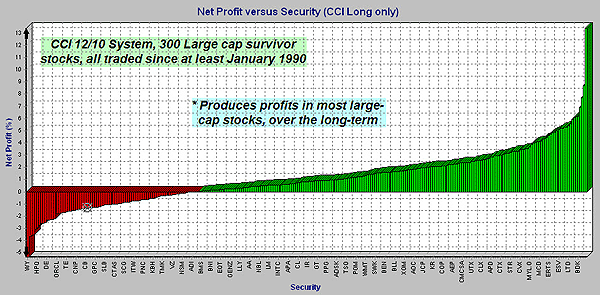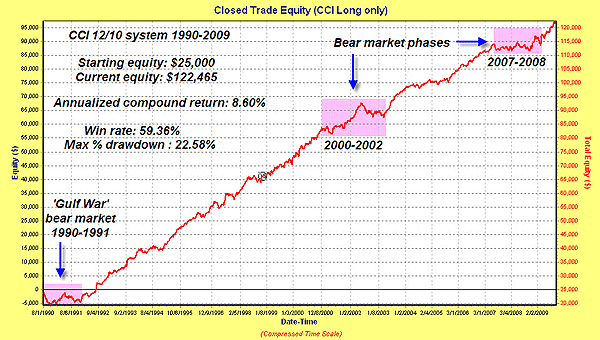
HOT TOPICS LIST
- MACD
- Fibonacci
- RSI
- Gann
- ADXR
- Stochastics
- Volume
- Triangles
- Futures
- Cycles
- Volatility
- ZIGZAG
- MESA
- Retracement
- Aroon
INDICATORS LIST
LIST OF TOPICS
PRINT THIS ARTICLE
by Donald W. Pendergast, Jr.
There is no holy grail trading system, but there are real-world mechanical methods that can make decent money over time. Here's a look at one system that shows a great deal of promise.
Position: N/A
Donald W. Pendergast, Jr.
Donald W. Pendergast is a financial markets consultant who offers specialized services to stock brokers and high net worth individuals who seek a better bottom line for their portfolios.
PRINT THIS ARTICLE
TRADING SYSTEMS
A Trading System To Build On
10/27/09 03:14:40 PMby Donald W. Pendergast, Jr.
There is no holy grail trading system, but there are real-world mechanical methods that can make decent money over time. Here's a look at one system that shows a great deal of promise.
Position: N/A
| I don't know about you, but I've seen trading systems advertised for sale at $5,000 and others that you can lease for about $200–300 per month. Certainly, at least some of these systems are worthy of such an investment, but is there a more inexpensive way to extract consistent profits from the stock market, perhaps with a basic system that almost anyone can construct in MetaStock, AIQ, or TradeStation? Perhaps there is, and hopefully the stock trading system I will describe here will lay a solid foundation that you can take and further fine-tune until it becomes something truly extraordinary. All you need is the patience of Job and the persistence of Thomas Edison, and you too could end up as the proud owner/operator of a profitable trading system if you are willing to work at it with all your heart, believing that you will find a way to make it work for you. With that advice taken to heart, let's take at look at the system. |

|
| FIGURE 1: CCI 12/10. No system wins all the time, but this simple CCI-based method produced a net profit in more than 75% of the 300 large-cap stocks used during the 19-year backtest. |
| Graphic provided by: Compuvision's TradeSim Enterprise. |
| |
| Here's the Compuvision TradeSim Enterprise MetaStock exploration code for a long-only commodity channel index (CCI)–based stock trading system, one tested on a variety of large-cap stocks (about 300 stocks) that have continuously traded since at least January 1990: EntryTrigger := Ref(Cross( CCI(12),-100),-1)AND CMF(34)>(0)AND CMF(144)>(0); EntryPrice := OPEN; ExitTrigger := Ref(Cross( 100, CCI(10)),-1); ExitPrice := OPEN; ExtFml( "TradeSim.Initialize"); ExtFml("TradeSim.EnableProtectiveStop",0); InitialStop:=0.92 * EntryPrice; ExtFml( "TradeSim.RecordTrades", "CCI Long only", { Trade Data Filename } LONG, { Trade Position Type } EntryTrigger, { Entry Trigger } EntryPrice, { Entry Price } InitialStop, { Optional Initial Stop } ExitTrigger, { Exit Trigger } ExitPrice, { Exit Price } START); { Recorder Control } The essentials in the system are simple — buy the stock when the 12-period CCI drops below -100 and then sell it when the 10-period CCI rises above 100. A fixed 8% stop-loss was used on every trade; no trailing stop was used. In addition, both the CMF(34) and CMF(144) money flow indicators need to be above their respective zero-lines at the time of the CCI 12 drop below -100. That's it, that's the system. In system designer terms, this system has only three degrees of freedom (three variables) to work with when screening for trades, and as most professional system developers will admit, the fewer variables that are included in any given trading system, the better. Systems with too many variables will typically give terrific back tested results, but when they are traded with real money in the real world, they tend to disintegrate. That's because of the detrimental effects of curve-fitting and overoptimization. Anyway, for an idea of what this simple CCI pullback system can do, take a glance at the trade distribution graph seen in Figure 1. Even a novice system designer can see that the basic guts of this simple system are based on sound technical logic that produces positive outcomes most of the time, with nearly 80% of the stocks producing a net profit over the 19-plus year backtest. |

|
| FIGURE 2: CCI 12/10. When evaluating a trading system, make sure that the equity curve is relatively straight, with modest drawdowns. The power of disciplined, long-term compounding can turn even a plain-Jane trading system into a movie star system, given enough time. |
| Graphic provided by: Compuvision's TradeSim Enterprise. |
| |
| Figure 2 is a sample equity curve for the system; it is relatively smooth and produced remarkably modest drawdowns even during the savage bear markets of 1990–91, 2000–02 and 2007–08. Although the compounded returns of 8.60% seem modest, remember that 8.60% over a 19-plus year period turns $25,000 into more than $122,465 (which no doubt explains how "ordinary" people like janitors and truckers, who live within their means and who save every penny they can, often become millionaires by the time retirement rolls around). The relative smoothness of the equity line is equally attractive, meaning that a respectable rate of return doesn't always have to mean a stomach-turning roller-coaster ride through the financial markets. For those intent on really making this system rock, all they would need to do is trade this system in a IRA or Roth IRA retirement account, letting the gains compound at a truly astounding rate. As a famous TV personality/businessman/investor once said (he's reputedly worth $400 to $700 million), "Those who understand the power of compound interest, earn it. Those who don't, pay it." How true that statement is! |
| Here are the basic portfolio management parameters that were used to run the system. You may find that different parameters may produce better (or worse) results, so take some time and think these critical issues through before actually trading this system with real money. * Starting capital: $25,000 * Commissions: $0.008 per share, with a minimum commission of $1.00 for each side of the trade * Total max # of open positions: 6 * Max # of daily orders: 1 (only one new trade a day permitted) * Fraction of total trading capital per trade: 16.66% * Margin requirement: 100% * Enter trade at next session's open * Exit trade at next session's open This simple CCI 12/10 system isn't the be-all and end-all in trading system design, but it is an excellent starting point for aspiring system developers from which to begin their journey toward developing reliable systems that they can and will trade consistently and profitably. |
Donald W. Pendergast is a financial markets consultant who offers specialized services to stock brokers and high net worth individuals who seek a better bottom line for their portfolios.
| Title: | Writer, market consultant |
| Company: | Linear Trading Systems LLC |
| Jacksonville, FL 32217 | |
| Phone # for sales: | 904-239-9564 |
| E-mail address: | lineartradingsys@gmail.com |
Traders' Resource Links | |
| Linear Trading Systems LLC has not added any product or service information to TRADERS' RESOURCE. | |
Click here for more information about our publications!
Comments
Date: 10/28/09Rank: 3Comment:
Date: 10/28/09Rank: 5Comment:

|

Request Information From Our Sponsors
- StockCharts.com, Inc.
- Candle Patterns
- Candlestick Charting Explained
- Intermarket Technical Analysis
- John Murphy on Chart Analysis
- John Murphy's Chart Pattern Recognition
- John Murphy's Market Message
- MurphyExplainsMarketAnalysis-Intermarket Analysis
- MurphyExplainsMarketAnalysis-Visual Analysis
- StockCharts.com
- Technical Analysis of the Financial Markets
- The Visual Investor
- VectorVest, Inc.
- Executive Premier Workshop
- One-Day Options Course
- OptionsPro
- Retirement Income Workshop
- Sure-Fire Trading Systems (VectorVest, Inc.)
- Trading as a Business Workshop
- VectorVest 7 EOD
- VectorVest 7 RealTime/IntraDay
- VectorVest AutoTester
- VectorVest Educational Services
- VectorVest OnLine
- VectorVest Options Analyzer
- VectorVest ProGraphics v6.0
- VectorVest ProTrader 7
- VectorVest RealTime Derby Tool
- VectorVest Simulator
- VectorVest Variator
- VectorVest Watchdog
